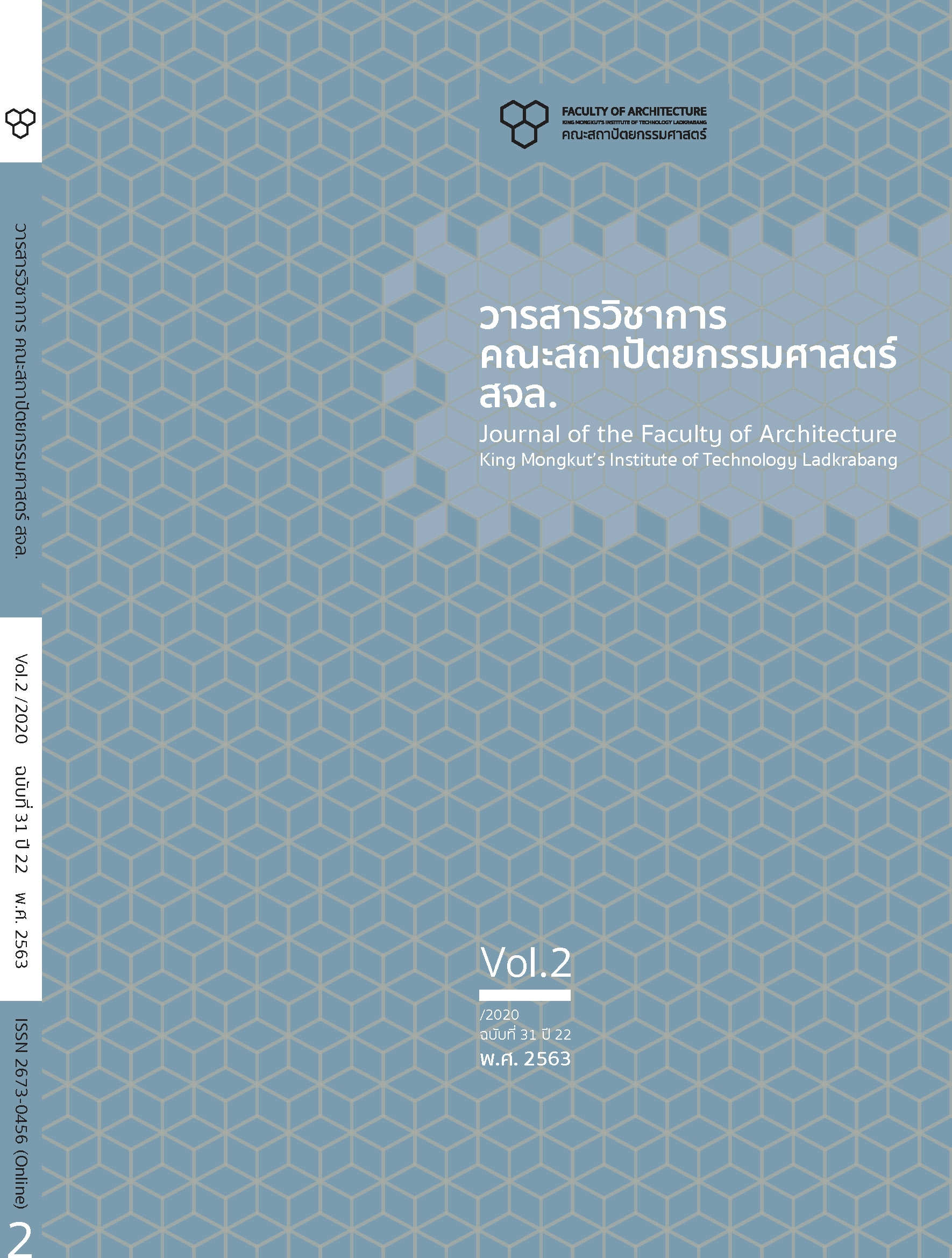Guidelines for Solid Waste Management by Urban Planning Measures: the Case Studies of Rangsit City Municipality, Bueng Yitho Municipality and Thaklong Municipality, Pathumthani Province
Main Article Content
Abstract
The purposes of this research study are to study the situations of solid waste management and people’s opinions towards solid waste management. Moreover, it aims to present the guidelines for solid
waste management with urban planning measures according to people’s needs and the conditions of Rangsit City, Bueng Yitho, and Thaklong municipalities, Pathumthani Province. The research instruments were field surveys (focusing on accumulating the data about solid waste collection, transportation, transformation, and disposal in the three municipalities) and interviews (emphasizing on collecting the data about opinions towards the causes, problems, and guidelines for solid waste management by using the purposive sampling method that selected 5 public organizations and 15 communities). It was found that solid waste management of the three municipalities was responsible by the Municipal Office. Since the amounts of the solid wastes were high and there was no solid waste disposal area. As a result, private companies were hired to manage. Therefore, the public organizations and people considered that collecting and transporting the solid wastes did not cover some areas. Additionally, the rapid urban expansion and solid wastes disposal areas that were usually opposed by communities. So, the increasing amounts of solid wastes would be serious problems in the future. The guidelines for solid waste management with the urban planning measures are as follows: preparing public utility plans and reserving the rights to use lands at municipal solid waste separation stations, improving tax exemption regulations and fees for the communities or establishments supporting solid waste management, adjusting the compensation regulation for people living or having lands near solid waste transportation and separation stations, and preparing the short-term and long-term budget plans for solid waste management of the municipalities.
Article Details
This work is licensed under a Creative Commons Attribution-NonCommercial-ShareAlike 4.0 International License.
Copyright Transfer Statement
The copyright of this article is transferred to Journal of The Faculty of Architecture King Mongkut's Institute of Technology Ladkrabang with effect if and when the article is accepted for publication. The copyright transfer covers the exclusive right to reproduce and distribute the article, including reprints, translations, photographic reproductions, electronic form (offline, online) or any other reproductions of similar nature.
The author warrants that this contribution is original and that he/she has full power to make this grant. The author signs for and accepts responsibility for releasing this material on behalf of any and all co-authors.
References
กรมควบคุมมลพิษ. (2547). การจัดการขยะมูลฝอยชุมชนอย่างครบวงจร คู่มือสำหรับผู้บริหารองค์กรปกครองส่วนท้องถิ่น. กรุงเทพฯ: โรงพิมพ์คุรุสภาลาดพร้าว.
กรมควบคุมมลพิษ. (2552). คู่มือสำหรับผู้บริหารองค์กรปกครองส่วนท้องถิ่น การจัดการขยะมูลฝอยชุมชนอย่างครบวงจร. กรุงเทพฯ: กรมควบคุมมลพิษ.
กรมควบคุมมลพิษ. (2563). ข้อมูลสถานการณ์ขยะมูลฝอยขององค์กรปกครองส่วนท้องถิ่น. เข้าถึงได้จาก: https://thaimsw.pcd.go.th/report5.php.
กรมส่งเสริมการปกครองท้องถิ่น. (ม.ป.ป.). มาตรฐานการจัดการขยะมูลฝอยและสิ่งปฏิกูล. เข้าถึงได้จาก: http://www.dla.go.th/servlet/EbookServlet?_mode=detail&ebookId=10&random=1362641610241.
คณะทำงานจัดทำแผนบริหารจัดการทรัพยากรธรรมชาติและสิ่งแวดล้อมระดับพื้นที่ด้านขยะมลฝอยและของเสียอันตราย.(2561). แนวทางการบริหารจัดการขยะมูลฝอยและของเสียอันตรายระดับพื้นที่. นนทบุรี: สำนักงานสิ่งแวดล้อม ภาคที่ 6 (นนทบุรี).
ชัยวิชิต พลหลา. (2560). แนวทางการบริหารจัดการขยะมูลฝอยชุมชนขององค์กรปกครองส่วนท้องถิ่น. (การค้นคว้าอิสระรัฐศาสตรมหาบัณฑิต สาขาวิชาบริหารรัฐกิจและกิจการสาธารณะ สำหรับนักบริหาร, มหาวิทยาลัยธรรมศาสตร์).
นพนันท์ ตาปนานนท์. (ม.ป.ป.). การวางแผนภาคและเมือง (Urban and Regional Planning). เอกสารคำสอนวิชา 2503515, กรุงเทพฯ: ม.ป.ท.
ปิยชาติ ศิลปสุวรรณ. (2557). ขยะมูลฝอยชุมชน ปัญหาใหญ่ที่ประเทศกำลังเผชิญ. เข้าถึงได้จาก: http://nrei.rmutsv.ac.th/sites/default/files/poprosal/บทความวิชาการขยะมูลฝอยชุมชนปัญหาใหญ่ที่ ประเทศกำลังเผชิญ.PDF.
สถาบันพัฒนาบุคลากรด้านการพัฒนาเมือง. (2561). เกณฑ์และมาตรฐานผังเมือง มาตรการ วิธีการและเครื่องมือ กรณีตัวอย่างของต่างประเทศ. กรุงเทพฯ: เพรส ครีเอชั่น.
สํานักงานคณะกรรมการกฤษฎีกา. (2535). พระราชบัญญัติการสาธารณสุข พ.ศ. ๒๕๓๕. เข้าถึงได้จาก: http://web.krisdika.go.th/data/law/law2/%A136/%A136-20-9999-update.pdf.
สำนักงานเทศบาลนครรังสิต. (2563). สภาพทั่วไปและข้อมูลพื้นฐาน. เข้าถึงจาก: http://rangsit.org/New/index.php/th/2014-11-07-07-51-09/typography.
สำนักงานเทศบาลเมืองท่าโขลง. (2563). ข้อมูลพื้นฐาน. เข้าถึงจาก: http://www.thaklongphathumtani.go.th/th/page/ข้อมูลพื้นฐาน_101.html.
สำนักงานเทศบาลเมืองบึงยี่โถ. (2563). เกี่ยวกับเทศบาลเมืองบึงยี่โถ. เข้าถึงจาก:https://www.buengyitho.go.th/about.
สำนักงานสถิติจังหวัดปทุมธานี. (2562). รายงานสถิติจังหวัดปทุมธานี พ.ศ. 2562. กรุงเทพฯ: สำนักงานสถิติจังหวัดปทุมธานี.
สำนักจัดการกากของเสียและสารอันตราย กรมควบคุมมลพิษ. (2557). หลักเกณฑ์และเอกสารวิชาการที่เกี่ยวข้องกับการจัดการขยะมูลฝอยและของเสียอันตราย. เข้าถึงได้จาก: http://infofile.pcd.go.th/waste/topic15.pdfCFID=19440059&CFTOKEN=14202960.
สำนักพัฒนามาตรฐาน กรมโยธาธิการและผังเมือง. (2549). เกณฑ์และมาตรฐานผังเมืองรวม พ.ศ. 2549. กรุงเทพฯ: โรงพิมพ์แห่งจุฬาลงกรณ์มหาวิทยาลัย.
American Planning Association. (2007). Planning and Urban Design Standards Student Edition. New Jersey: John Wiley and Son.
Cohen and Uphoff. (1981). Rural Development Participation: Concept and Measures for Project Design Implementation and Evaluation. Ithaca, NY: Rural Development Committee Center for International Studies, Cornell University.


